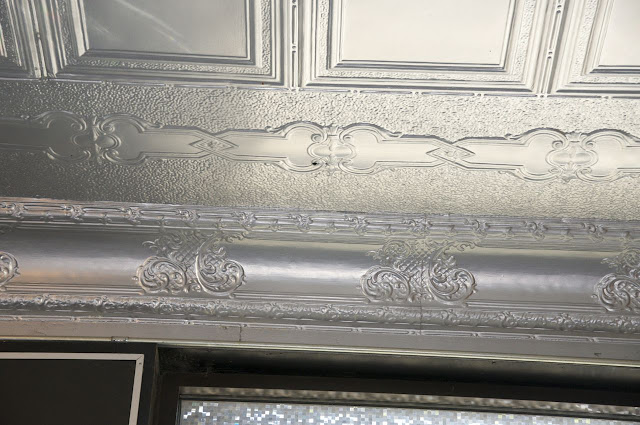The Nichols Elementary School building in Canton was constructed in 1927 (Jennifer Baughn, 2010,
Rosenwald Schools in Mississippi,
Mississippi History Now: An online publication of the Mississippi Historical Society). The plan was known as Rosenburg's T-plan, and was constructed for 7 teachers. The T-plan had an auditorium extending from the back side of the building, and tall windows along the sides to ensure sufficient lighting and cross-ventilation.
The
Canton Consolidated School cost a total of $25,000. Of that, $1500 was supplied by the black community, $21,800 by the public, and $1700 by Rosenwald funding (Fisk University Rosenwald Fund Card File Database).
...building facades were as simple as possible. (History of the Rosenwald School Program, National Trust for Historic Preservation)

In 1935, bonds were approved by Canton voters to supplement Public Works Administration funds for a new white junior high school and an elementary building for black children (Bonds approved for school at Canton,
Biloxi Daily Herald, December 11, 1935, p. 2). The bonds passed by a vote of 507 to 111 for $80,000 school bonds to be supplemented by $65,000 PWA funds.

Cameron Street High School complex contained a c. 1910 2 story high school for black students which is no longer extant (MDAH/HRI). Records indicate a 2 story building for elementary students was completed in 1937 by architects N. W. Overstreet and A. H. Town, built by J. R. Flint Construction Company. I surmised that it was this building, but it is located behind a locked and gated area and there was no access so I am unable to confirm. However, it is the only 2 story building in the Cameron Street complex. Report # 5 Status of completed non-federal allotted projects Mississippi, dated January 3, 1940, indicates funds for $66,690 were provided to Canton school 11/17/1936, contract awarded 2/15/1937, and construction completed 11/01/1937 (Federal Emergency Administration of Public Works Projects Division, p. 105). This tallies with the dates for the PWA additions to the
Canton High School, and the amount awarded by PWA.
While it is possible that those funds of $66, 690 represent the $65,000 initially sought, and that some of the funds were put toward the construction of this school--built in the same year--there is no documentation I have located that supports that. Architects for the two schools were Overstreet and Town, and thus, it seems reasonable to me that the funds could have been awarded to complete both projects. However, only the additions to the Canton High School are documented to have been constructed with PWA funds.
In 1958, the A. M. Rogers High School for black students was dedicated, and
Madison County had a new Negro high school today--the largest Negro school in the state--and Mississippi had a symbol of its hope of remaining in the public school business. White leaders have said that with the recent Supreme Court decisions that state's only hope of retaining public schools in through [sic] a system of voluntary segregation. The gleaming new structure dedicated Sunday is an example of the state's chief means of keeping Negroes in their own schools--building good new schools for them. But the Mississippi NAACP said 'Negro citizens will not accept as satisfactory this frantic makeshift school program which is designed as an answer to the Supreme Court decision on integration. (State's largest negro school dedicated at Canton; for 1,500, Greenville Delta Democrat Times, October 27, 1958, p. 2).
It was named for A. M. Rogers, who served as principal of the high
school for 25 years. The NAACP issued a statement that the school
has the striking resemblance of an auction barn...is inadequate to provide for each child the maximum educational opportunity that this day and age demand. (NAACP Assails new Negro school at Canton, Hattiesburg American, October 27, 1958, p. 1)
The organization further charged that the new junior-senior high school at Canton was ill-equipped and overtaxed (NAACP claims Canton school is inadequate,
Biloxi Daily Herald, October 29, 1958, p. 11). By January 1959, the issue had apparently resulted in a probe by the Madison County Grand Jury over the claim made by Medgar Evers, field secretary for the NAACP that the new half-million dollar school was overcrowded and poorly equipped; Evers stated the grand jury "approves of second class citizenship for Negroes" (NAACP leader raps jury report,
Biloxi Daily Herald, January 8, 1959, p. 16).
The NAACP considers anything less than equal rights for the races as second class citizenship. The grand jury said the school was a magnificent physical plant run efficiently. The school could handle 25 per cent more students than the average daily attendance, the jury added. Evers said the jury failed to point out that the county uses secondhand and overcrowded school buses and pays Negro drivers half what white drivers receive. (NAACP leader)
Fast forward six years. The
Hattiesburg American reported, in response to black students attempting to enroll in the "white" public high school:
Canton schools are not under any federal court order to desegregate as are four other schools systems in this state. (Canton again turns away Negro youths, September 8, 1964, p. 1)
The former high school is now the McNeal elementary school. Ironically, a bond went once again before the voters to build a new school, following charges that the building is overcrowded and inadequate to meet the needs of the students due to poor equipment (Kate Rogers, February 2, 2015, Schools seek $33M bond issue to improve elementary buildings,
The Clarion Ledger). Bid date for demolition of the McNeal elementary school is out for bid, due by September 3. The demolition will remove the existing school building and foundations, site pavements, utilities, and other site elements (Dale Partners, Architecture).























































